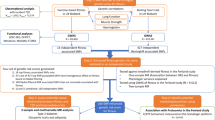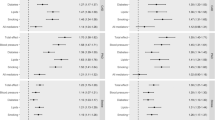Abstract
The association of single nucleotide polymorphisms (SNPs) from seven candidate genes, including genotype-by-baseline fitness and genotype-by-baseline body mass index (BMI) interactions, with incident hypertension over 20 years was investigated in 2663 participants (1301 blacks, 1362 whites) of the Coronary Artery Risk Development in Young Adults Study (CARDIA). Baseline cardiorespiratory fitness was determined from duration of a modified Balke treadmill test. A total of 98 SNPs in blacks and 89 SNPs in whites from seven candidate genes were genotyped. Participants that became hypertensive (295 blacks and 146 whites) had significantly higher blood pressure and BMI (both races), and lower fitness (blacks only) at baseline than those who remained normotensive. Markers at the peroxisome proliferative activated receptor gamma coactivator 1α (PPARGC1A) and bradykinin β2 receptor (BDKRB2) genes were nominally associated with greater risk of hypertension, although one marker each at the BDKRB2 and endothelial nitric oxide synthase-3 (NOS3) genes were nominally associated with lower risk. The association of baseline fitness with risk of hypertension was nominally modified by genotype at markers within the angiotensin converting enzyme, angiotensinogen, BDKRB2 and NOS3 genes in blacks and the BDKRB2, endothelin-1 and PPARGC1A genes in whites. BDKRB2 rs4900318 showed nominal interactions with baseline fitness on the risk of hypertension in both races. The association of baseline BMI with risk of hypertension was nominally modified by GNB3 rs2301339 genotype in whites. None of the above associations were statistically significant after correcting for multiple testing. We found that SNPs in these candidate genes did not modify the association between baseline fitness or BMI and risk of hypertension in CARDIA participants.
This is a preview of subscription content, access via your institution
Access options
Subscribe to this journal
Receive 12 digital issues and online access to articles
$119.00 per year
only $9.92 per issue
Buy this article
- Purchase on Springer Link
- Instant access to full article PDF
Prices may be subject to local taxes which are calculated during checkout

Similar content being viewed by others
References
Fields LE, Burt VL, Cutler JA, Hughes J, Roccella EJ, Sorlie P . The burden of adult hypertension in the United States 1999 to 2000: a rising tide. Hypertension 2004; 44: 398–404.
Barlow CE, LaMonte MJ, FitzGerald SJ, Kampert JB, Perrin JL, Blair SN . Cardiorespiratory fitness is an independent predictor of hypertension incidence among initially normotensive healthy women. Am J Epidemiol 2006; 163: 142–150.
Blair SN, Goodyear NN, Gibbons LW, Cooper KH . Physical fitness and incidence of hypertension in healthy normotensive men and women. JAMA 1984; 252: 487–490.
Carnethon MR, Gidding SS, Nehgme R, Sidney S, Jacobs Jr DR, Liu K . Cardiorespiratory fitness in young adulthood and the development of cardiovascular disease risk factors. JAMA 2003; 290: 3092–3100.
Sawada S, Tanaka H, Funakoshi M, Shindo M, Kono S, Ishiko T . Five year prospective study on blood pressure and maximal oxygen uptake. Clin Exp Pharmacol Physiol 1993; 20: 483–487.
Dyer AR, Liu K, Walsh M, Kiefe C, Jacobs Jr DR, Bild DE . Ten-year incidence of elevated blood pressure and its predictors: the CARDIA study. Coronary artery risk development in (young) adults. J Hum Hypertens 1999; 13: 13–21.
Gelber RP, Gaziano JM, Manson JE, Buring JE, Sesso HD . A prospective study of body mass index and the risk of developing hypertension in men. Am J Hypertens 2007; 20: 370–377.
Hu G, Barengo NC, Tuomilehto J, Lakka TA, Nissinen A, Jousilahti P . Relationship of physical activity and body mass index to the risk of hypertension: a prospective study in Finland. Hypertension 2004; 43: 25–30.
Wilson PW, D’Agostino RB, Sullivan L, Parise H, Kannel WB . Overweight and obesity as determinants of cardiovascular risk: the Framingham experience. Arch Intern Med 2002; 162: 1867–1872.
Rankinen T, Church TS, Rice T, Bouchard C, Blair SN . Cardiorespiratory fitness, BMI and risk of hypertension: the HYPGENE study. Med Sci Sports Exerc 2007; 39: 1687–1692.
Bouchard C, Rankinen T . Individual differences in response to regular physical activity. Med Sci Sports Exerc 2001; 33: S446–S451.
An P, Perusse L, Rankinen T, Borecki IB, Gagnon J, Leon AS et al. Familial aggregation of exercise heart rate and blood pressure in response to 20 weeks of endurance training: the HERITAGE family study. Int J Sports Med 2003; 24: 57–62.
An P, Rice T, Gagnon J, Leon AS, Skinner JS, Bouchard C et al. Familial aggregation of stroke volume and cardiac output during submaximal exercise: the HERITAGE Family Study. Int J Sports Med 2000; 21: 566–572.
Rice T, An P, Gagnon J, Leon AS, Skinner JS, Wilmore JH et al. Heritability of HR and BP response to exercise training in the HERITAGE family Study. Med Sci Sports Exerc 2002; 34: 972–979.
Rankinen T, Gagnon J, Perusse L, Chagnon YC, Rice T, Leon AS et al. AGT M235T and ACE ID polymorphisms and exercise blood pressure in the HERITAGE Family Study. Am J Physiol Heart Circ Physiol 2000; 279: H368–H374.
Rankinen T, Rice T, Perusse L, Chagnon YC, Gagnon J, Leon AS et al. NOS3 Glu298Asp genotype and blood pressure response to endurance training: the HERITAGE family study. Hypertension 2000; 36: 885–889.
Brito EC, Vimaleswaran KS, Brage S, Andersen LB, Sardinha LB, Wareham NJ et al. PPARGC1A sequence variation and cardiovascular risk-factor levels: a study of the main genetic effects and gene × environment interactions in children from the European Youth Heart Study. Diabetologia 2009; 52: 609–613.
Grove ML, Morrison A, Folsom AR, Boerwinkle E, Hoelscher DM, Bray MS . Gene–environment interaction and the GNB3 gene in the atherosclerosis risk in communities study. Int J Obes (Lond) 2007; 31: 919–926.
Kimura T, Yokoyama T, Matsumura Y, Yoshiike N, Date C, Muramatsu M et al. NOS3 genotype-dependent correlation between blood pressure and physical activity. Hypertension 2003; 41: 355–360.
Vimaleswaran KS, Franks PW, Barroso I, Brage S, Ekelund U, Wareham NJ et al. Habitual energy expenditure modifies the association between NOS3 gene polymorphisms and blood pressure. Am J Hypertens 2008; 21: 297–302.
Friedman GD, Cutter GR, Donahue RP, Hughes GH, Hulley SB, Jacobs Jr DR et al. CARDIA: study design, recruitment, and some characteristics of the examined subjects. J Clin Epidemiol 1988; 41: 1105–1116.
Carnethon MR, Sternfeld B, Schreiner PJ, Jacobs Jr DR, Lewis CE, Liu K et al. Association of 20-year changes in cardiorespiratory fitness with incident type 2 diabetes: the coronary artery risk development in young adults (CARDIA) fitness study. Diabetes Care 2009; 32: 1284–1288.
Chobanian AV, Bakris GL, Black HR, Cushman WC, Green LA, Izzo Jr JL et al. The Seventh Report of the Joint National Committee on Prevention, Detection, Evaluation, and Treatment of High Blood Pressure: the JNC 7 report. Jama 2003; 289: 2560–2572.
Sidney S, Haskell WL, Crow R, Sternfeld B, Oberman A, Armstrong MA et al. Symptom-limited graded treadmill exercise testing in young adults in the CARDIA study. Med Sci Sports Exerc 1992; 24: 177–183.
Bray MS, Hagberg JM, Perusse L, Rankinen T, Roth SM, Wolfarth B et al. The human gene map for performance and health-related fitness phenotypes: the 2006-2007 update. Med Sci Sports Exerc 2009; 41: 35–73.
Barrett JC, Fry B, Maller J, Daly MJ . Haploview: analysis and visualization of LD and haplotype maps. Bioinformatics 2005; 21: 263–265.
International HapMap Consortium. The International HapMap Project. Nature 2003; 426: 789–796.
de Bakker PI, Yelensky R, Pe’er I, Gabriel SB, Daly MJ, Altshuler D . Efficiency and power in genetic association studies. Nat Genet 2005; 37: 1217–1223.
Abecasis GR, Cookson WOC . GOLD--graphical overview of linkage disequilibrium. Bioinformatics 2000; 16: 182–183.
Nyholt DR . A simple correction for multiple testing for single-nucleotide polymorphisms in linkage disequilibrium with each other. Am J Hum Genet 2004; 74: 765–769.
Gauderman WJ, Morrison JM . QUANTO 1.1: A computer program for power and sample size calculations for genetic-epidemiology studies. 2006; Available from: http://hydra.usc.edu/gxe.
Agarwal A, Williams GH, Fisher ND . Genetics of human hypertension. Trends Endocrinol Metab 2005; 16: 127–133.
Marteau JB, Zaiou M, Siest G, Visvikis-Siest S . Genetic determinants of blood pressure regulation. J Hypertens 2005; 23: 2127–2143.
Wellcome Trust Case Control Consortium. Genome-wide association study of 14 000 cases of seven common diseases and 3000 shared controls. Nature 2007; 447: 661–678.
Charchar F, Zimmerli L, Tomaszewski M . The pressure of finding human hypertension genes: new tools, old dilemmas. J Hum Hypertens 2008; 22: 821–828.
Levy D, Larson MG, Benjamin EJ, Newton-Cheh C, Wang TJ, Hwang SJ et al. Framingham Heart Study 100K project: genome-wide associations for blood pressure and arterial stiffness. BMC Med Genet 2007; 8: S3.
McCarthy MI, Abecasis GR, Cardon LR, Goldstein DB, Little J, Ioannidis JP et al. Genome-wide association studies for complex traits: consensus, uncertainty and challenges. Nat Rev Genet 2008; 9: 356–369.
Tiret L . Gene-environment interaction: a central concept in multifactorial diseases. Proc Nutr Soc 2002; 61: 457–463.
Talmud PJ . How to identify gene-environment interactions in a multifactorial disease: CHD as an example. Proc Nutr Soc 2004; 63: 5–10.
Luan JA, Wong MY, Day NE, Wareham NJ . Sample size determination for studies of gene-environment interaction. Int J Epidemiol 2001; 30: 1035–1040.
Wong MY, Day NE, Luan JA, Chan KP, Wareham NJ . The detection of gene-environment interaction for continuous traits: should we deal with measurement error by bigger studies or better measurement? Int J Epidemiol 2003; 32: 51–57.
Goodman SN, Berlin JA . The use of predicted confidence intervals when planning experiments and the misuse of power when interpreting results. Ann Intern Med 1994; 121: 200–206.
Franks PW . Identifying genes for primary hypertension: methodological limitations and gene-environment interactions. J Hum Hypertens 2009; 23: 227–237.
Haskell WL, Lee IM, Pate RR, Powell KE, Blair SN, Franklin BA . Physical Activity and Public Health: updated recommendation for adults from the American College of Sports Medicine the American Heart Association. Circulation 2007; 116: 1081–1093.
Acknowledgements
The Coronary Artery Risk Development in Young Adults study is supported by the National Heart, Lung,and Blood Institute (grants N01-HC-48047, N01-HC-48048, N01-HC-48049, N01-HC-48050 and N01-HC-95095). The CARDIA Fitness study is supported by R01 HL 078972.
Author information
Authors and Affiliations
Corresponding author
Ethics declarations
Competing interests
The authors declare no conflict of interest.
Additional information
Supplementary Information accompanies the paper on the Journal of Human Hypertension website
Supplementary information
Rights and permissions
About this article
Cite this article
Sarzynski, M., Rankinen, T., Sternfeld, B. et al. SNP-by-fitness and SNP-by-BMI interactions from seven candidate genes and incident hypertension after 20 years of follow-up: the CARDIA Fitness Study. J Hum Hypertens 25, 509–518 (2011). https://doi.org/10.1038/jhh.2010.94
Received:
Revised:
Accepted:
Published:
Issue Date:
DOI: https://doi.org/10.1038/jhh.2010.94
Keywords
This article is cited by
-
Physical Activity and the Prevention of Hypertension
Current Hypertension Reports (2013)
-
Endothelin antagonists in hypertension and kidney disease
Pediatric Nephrology (2013)



